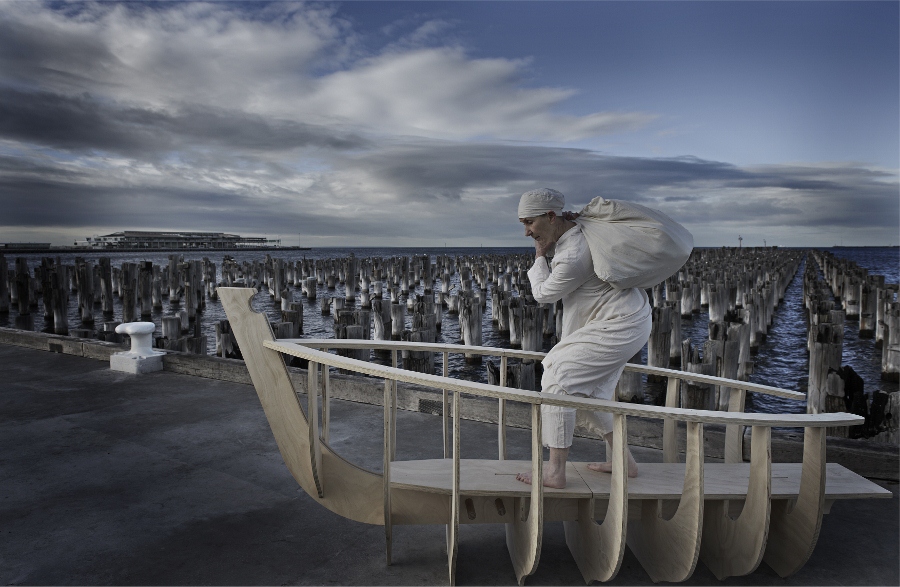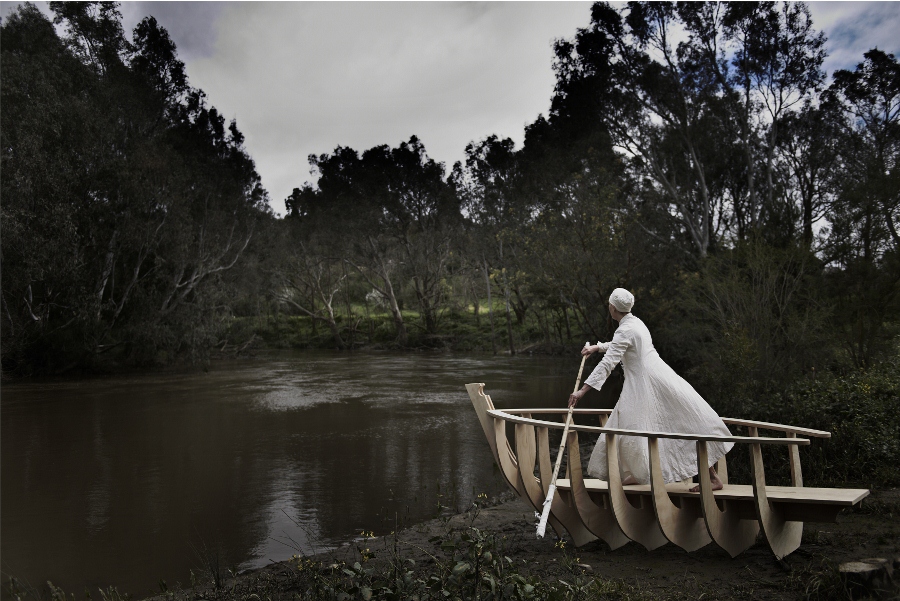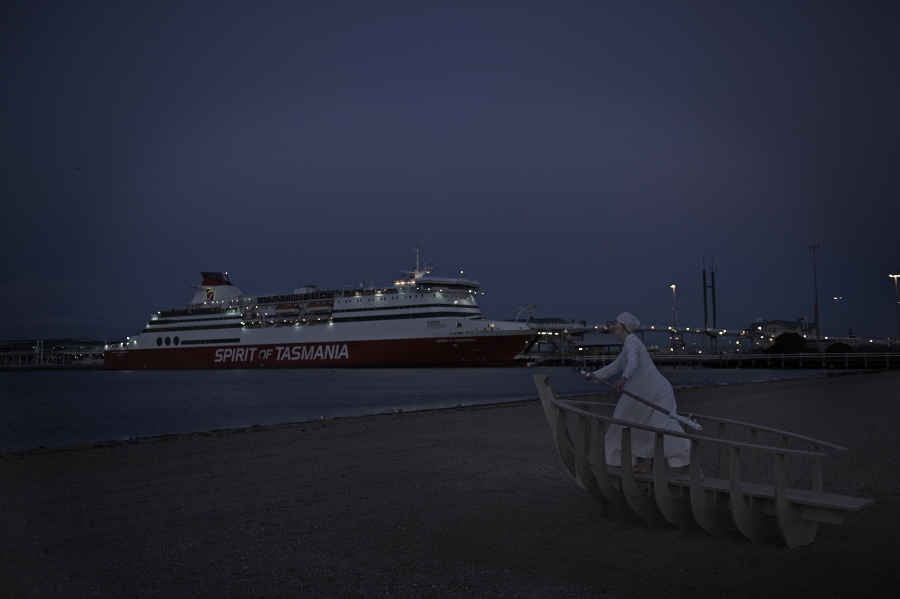Jill Orr, The Promised Land and the Performance artist, Part 2

In Part Two of this fascinating interview with performance artist Jill Orr for Art World Women , Claire Bridge discusses with Orr aspects of body image, symbolism, feminism and the role of emotion for the artist and in performance art. Part One discussed Orr’s exhibition ‘The Promised Land’ in depth. You can read Part 1 here.
image above: Jill Orr The Promised Land – walking 2012, Photographer: Christina Simons for Jill Orr, © Jill Orr 2012
AWW: Elemental symbols feature and recur in your work: fire, ash, water, earth, water, sea, sky, fog amongst them. What is your relationship with these elements? How do they speak to you? How has their meaning changed through time for you?
JO: The elements are the transformative building blocks that are tools in ritual and share metaphoric, symbolic and practical relationships to each other. They are the basic building blocks. Fire, air, water and earth are each necessary for life, each participating in an ‘alchemical’ exchange. For example the weather is a perfect demonstration of this molecular exchange that never stops but is in eternal cyclic transformation. It acts on, with and through the environment, of which we are dependant and intricately part of. That is why the elements hold such importance for me and over time I am more convinced of that.
AWW: Your work has a richness and depth of symbolism. The concepts are complex and demanding. How do you find ways to strip back to the essential elements? How do you decide which elements will speak most profoundly and yet simply at the same time?
JO: The imagined images I receive are gifts that I have to honour by giving them the due process they deserve. It is through this process that I have to listen to carefully and through that, the work becomes distilled. I don’t say something is profound. Profundity is in the eye of the beholder.

AWW: Your body, your presence is part of your work. As a performance artist, your work is not separate or apart from you. What happens to your art if you can not be there? Is the performance aspect of your work always necessary? What happens if or when you can not perform?
JO: I have always concentrated purely on performance, albeit painting has usually accompanied this. It is interesting that you ask this question because I had to cancel the live aspect of this work hosted in the John Buckley Gallery because I had an illness that rendered me unable to walk properly. Luckily this will heal. I guess one adapts to changing circumstances and invents other ways to work. I have worked with others however this is demanding in an intense organizational way and after these works, I have needed to return to myself. I don’t know what the future will hold.
AWW: How do you perceive your body in relation to your art? How do you perceive your body in relationship to the general mass consensus’s message about a woman’s body?
JO: I’m not sure I know what you mean about mass consensus’s message about a woman’s body. Does the mass consent? What does it consent to? I see there several waves of feminisms and some waves of repulsion about feminisms. There is mass media that impacts on the insecurities and vulnerabilities of self-esteem intricately connected to body image where beauty is an ideal constructed by the fashion makers, usually unattainable by most and the attainment is a brief moment in time anyway. This now impacts males and females. I had worked a lot on the question of body and self in relation to others and came out understanding that for me, I could imagine and become anything and if there was an essential self, it may be hidden till the end. I guess I am now old enough that aging gracefully is not dependent on what others think, but that has been quite a journey to really know this. The body in relation to my art evolves as I do – it is a vehicle for expression.
AWW: How do you go about conceiving a performance once the idea or notion has taken root in your imagination?
JO: That depends on the work. Ultimately, I have to figure out how to translate what I see into physical realms and then if I need to perform it to an audience and or the camera. What site/location is best or do I make an environment myself? Each work requires a different set of tactics but I have mentioned the three most consistent.

AWW: Marina Abramovic spoke of “unconditional love” arising in her work the ‘Artist is Present’. What role does compassion have in art? Or rather what role do artists have in talking about and expressing such noble emotions of compassion, love, courage, forgiveness and acceptance through their work?
JO: Jill Bennett has written ‘Empathic Vision : Affect, Trauma and Contemporary Art ’ that looks at trauma in art. My reading is that Bennett notes that because trauma itself cannot be expressed, trauma is felt through the affect of an artwork. This is very different to the mere description of traumatic symptoms. The affect of an artwork is the power to impact emotionally. Emotions can be evoked through other vehicles, the art, the performance, the engagement with a community, something that enables an experience and through that experience comes the emotion. Emotional states cannot be manufactured from nothing. In this sense, Marina’s performances provided the vehicle to experience emotions rather than describe them. The noble emotions you describe are certainly worthy of attention given these are an end point to healing but the whole process through anger, grief , melancholy etc. need expression before any of the nobler ones can be felt authentically.
AWW: You work collaboratively at times. What is this like for you working with others in performance?
JO: Working with others is always wonderful. They bring to the work a richness that is unpredictable and challenging and rewarding. Actually I frequently collaborate with photographers, musicians and printers, but less frequently with other performers. Having said that, the last collaboration was recently at the Melaka Visual and Performance Festival in Malaysia. Tony Yap is the creative director. Here dancers and performers from thirty different countries worked individually and collaboratively to create an amazing series of works. We were each a sum of the greater whole because we could listen, watch and respond to each other in the space of performance. Very special for audiences and performers.

AWW: In your view, why is it that it is women who are frequently drawn to work so powerfully with performance and new media?
JO: Maybe woman are used to putting on a face consciously before they enter the public sphere. This act is trained, gendered and can be constructed, de-constructed and performed throughout life. The extension into performative realms could be seen as a natural extension. Reflected and mirrored is the image screen that lies between identification and the other and this could be a factor that is attractive to women. I think that performance is attractive to anyone needing to unpick, redefine and analyse, through the phenomenological distance that performance gives between the self and the other. The articulation of difference applies to gendered, gay, religious and racial identification within, without or in-between the mainstream. Performance is a way to swim through it.
AWW: You have been invited to perform in the inaugural “Venice International Performance Art Week” alongside artists such as Yoko Ono. This is a wonderful recognition. What are your plans for this?
JO: I am going to take ‘The Promised Land’, both boat and photographs from which I will do the live performance of this work. I will also create another work in the streets of Venice.
AWW: What is next for you?
The past few years have been intense and I hope to have a short holiday.
Read more about ‘The Promised Land’, Jill Orr’s exhibition, in Part 1
Jill Orr is represented by Jenny Port Gallery
The Promised Land, 2012, hosted by John Buckley Gallery.
Photographer: Christina Simons for Jill Orr
All images copyright Jill Orr 2012
1 thought on “Jill Orr, The Promised Land and the Performance artist, Part 2”